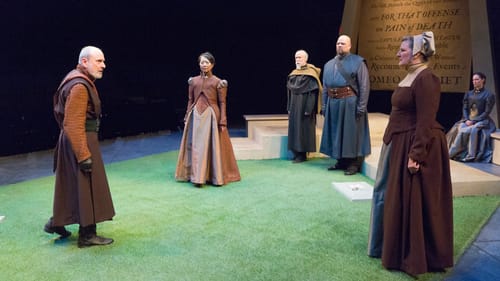Stay in the Loop
BSR publishes on a weekly schedule, with an email newsletter every Wednesday and Thursday morning. There’s no paywall, and subscribing is always free.
New life for an old story
People's Light presents Zak Berkman and Samantha Reading's 'Romeo & Juliet: A Requiem'

Consider the strange case of People’s Light & Theatre Company’s Romeo & Juliet: A Requiem. As a small-cast, 90-minute telling of William Shakespeare’s tragedy, it fits current theater fashion and economic necessity. Yet it’s also another play entirely.
Director Samantha Reading’s fascinating cutting and rearrangement of Shakespeare’s text tells the familiar story, but the scenario conceived by Reading and Zak Berkman starts a year after the play’s events. The Capulet and Montague houses still feud despite the reconciliation promised at the play’s end, and the Prince of Verona has ordered them, along with the Friar (Graham Smith) and the Nurse (Marcia Saunders), to “recount the tragic events” — as a flyer handed to each patron, and two large banners onstage, explain.
Presumably, this public airing will help their wounds finally heal.
Swords ready
When Lord Capulet (Stephen Novelli) and Lady Capulet (Jeanne Sakata) meet Lord Montague (Brian Anthony Wilson), the tension is palpable. Almost unnoticed, though present when the house opens, Lady Montague (Teri Lamm) sits off to the side; since she’s reported dead in Romeo & Juliet, her presence is a mystery to all.
They meet on James F. Pyne Jr.’s austere yet warm set, a graveyard with six symmetrically placed graves. Two of the dead are, of course, Romeo and Juliet; the others are Tybalt, Mercutio, Paris, and Lady Montague.
A garment lies on each grave (Marla Jurglanis designed the handsome costumes). These clothes are donned by actors as they play each role in the story. Christopher Colucci’s haunting, contemplative music underscores many scenes, and Deborah Constantine’s lighting is likewise subtle.
Reading’s innovative script repurposes lines to set the scene. She shows events out of chronological order, and characters’ views are played as subtext. For example, Lady Capulet reluctantly utters Juliet’s “My only love springs from my only hate!” with venom, since she (Lady Capulet) blames the hated Montagues for Juliet’s death.

Processing these layers is fascinating for the audience, but perhaps more brainwork than we’re accustomed to; I fear those who don't know Romeo and Juliet could be lost. Part of Requiem’s intended audience, however, is high-school students studying Shakespeare, and few escape high school without encountering the play.
Love Goes Toward Love
Romeo’s line “love goes toward love” proves prescient, as the Montagues and Capulets find solace in reliving their children’s doomed relationship. One of Requiem’s many charms is that actors who would never be cast in these roles get to play them. We see the physically imposing Wilson play his giddy love-struck teenage son, for example, while both Capulets and Lady Montague play Juliet at different times.
All perform multiple roles, clearly discovering empathy for the characters as their remorse and resentment fall away. Each in their own way shows new understanding like the sun breaking through clouds, while embodying the original story — all without explanation in words.
So why create this retelling? It won’t, and shouldn’t, replace more traditional Romeo and Juliet productions. Instead, it shows how Shakespeare’s tidy resolution wouldn’t work in the real world. True reconciliation and growth take time, effort, and empathy, with enormous obstacles of ingrained hatred and fear to overcome.
In that sense, Requiem — without a newly written word to explain itself — does more than the Wilma Theater’s Passage, with similar themes. Can we ever truly be friends with our enemies? Can love replace hate?
Shakespeare had a theory, and People’s Light’s Requiem does much to prove it.
What, When, Where
Romeo & Juliet: A Requiem. By Zak Berkman and Samantha Reading, Samantha Reading directed. Through May 27, 2018, at the People's Light & Theatre Company’s Leonard C. Haas Stage, 39 Conestoga Road, Malvern, Pennsylvania. (610) 647-1900 or peopleslight.org.
Sign up for our newsletter
All of the week's new articles, all in one place. Sign up for the free weekly BSR newsletters, and don't miss a conversation.

 Mark Cofta
Mark Cofta